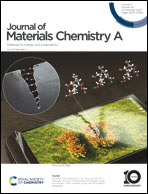Investigation of structure–property–application relationships of a hydrogel-based solar vapor generator†
Abstract
Without requiring any extra energy, a polymeric hydrogel based solar vapor generator (SVG) offers a promising complement to current energy-intensive desalination processes. The hydrophilic groups of polymer hydrogels can interact with water molecules through hydrogen bonding, thereby activating other adjacent water molecules to an intermediate water state, thus lowering the total enthalpy of water and making it easier to evaporate. However, there is still a knowledge gap in the structure–property relationships between hydrogel functional groups and water molecules. Here, we prepare seven hydrogels containing different functional groups, fairly compare their hydration ability and establish the relationship between the hydrophilic groups and the properties (e.g., evaporation enthalpy, electrostatic potential, etc.) of the corresponding polymer hydrogels, as well as their solar evaporation performance. The resultant polyacrylamide (PAM) SVG with –NH2 groups, standing out from the other hydrogels, shows rapid water replenishment capability, a high intermediate water content of 78.2%, low equivalent water vaporization enthalpy, an excellent seawater evaporation rate of 3.41 kg m−1 h−1, and excellent desalination capacity to reduce the main ion concentrations by 3–5 orders. We expect that this fundamental research could provide guidance for the development of future SVGs and ultimately contribute to the development of efficient solar vapor generation systems.



 Please wait while we load your content...
Please wait while we load your content...